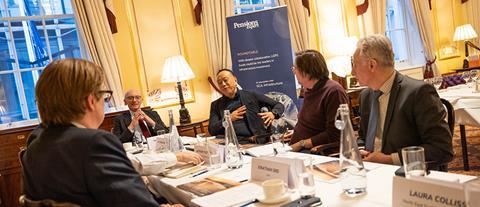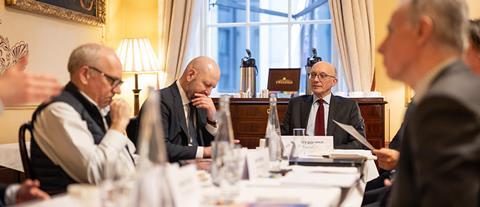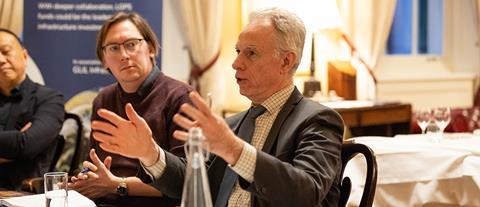Through roundtable discussions sponsored by GLIL Infrastructure, the specialist investor discussed with Local Government Pension Scheme representatives how the fund’s newest transaction aligns with its objectives while considering its impact on local areas.
At a recent roundtable hosted by DG Publishing, Jonathan Ord, head of investment at GLIL Infrastructure (GLIL), and Matthew Graham, chief business development officer at Local Pensions Partnership Investments (the Alternative Investment Fund Manager for GLIL), discussed the fund’s current objectives amid recent government consultations.
They also shared how the fund’s latest investment aligns with its founding goals, highlighting the benefits, its fit within the wider portfolio, and its impacts on both biodiversity and the local community.

Growing the fund to new investors
The recent government consultation on LGPS investments has opened the door for discussions on collaboration between funds.
Graham highlighted that GLIL’s supervisory board, which includes Local Pensions Partnership Investments, Greater Manchester, West Yorkshire, and Merseyside pension funds, is seizing this opportunity to expand the fund beyond its current investors.
He said that the fund’s goal is to expand not just by investing in more assets, but also by bringing in new investors, especially other LGPS funds. However, he emphasised that while LGPS funds are the primary stakeholders, the fund is not limited to LGPS investors.
“It’s not solely an LGPS fund. Nest, the DC master trust, is in there. This is an infrastructure vehicle that is co-owned by LGPS funds and pools, as it stands at the moment’,” he said.
Graham acknowledged that, in order for the fund to truly broaden its appeal and attract more investors, it must recognise that scale investors may want a seat on the supervisory board.

GLIL’s newest investment
The recent LGPS consultation also highlighted the importance of boosting investments in UK infrastructure. Ord explained that GLIL’s latest transaction aligns with this goal.
One new investment is the strategic partnership with the Bluefield Solar Income Fund (Bluefield), which is a portfolio of operational solar farms, including a floating solar farm. This sector was selected because, two years ago, GLIL identified solar energy in the UK as an attractive area for investment, he said.
“We’ve entered into a strategic partnership with Bluefield, which we have named Lyceum Solar, a series of transactions that started 12 months ago and will complete during this year. The first part of that was buying an operational portfolio, so we bought a portfolio of solar farms producing 247 megawatts,” he said.
He said that GLIL has then added further portfolios to that, and the last part of the investment involves acquiring a portfolio of ready-to-build sites that the joint venture will take through construction because the fund wants to build new solar farms in the UK.
“We are very much focused on inflation-linked cash flows, so having the operational portfolio helps generate that, and then we’re able to generate a return premium and also support the government’s agenda around building new energy transition infrastructure assets in the UK,” he said.
Ord added that, beyond these benefits, the investment also aligns with the fund’s strategy of being a long-term investor, a principle that is embedded in all its activities.
“A key reason why GLIL started in the first place was that the pension funds wanted to hold these assets for the long term whilst the commercial asset managers were looking to sell assets after five or seven years. Bluefield is also a long-term investor, so we’re very aligned on that point,” he said.

Impact on biodiversity
The sustainability of the investment is evident due to the renewable energy aspect of solar panels. However, during the roundtable, William Bourne, principal of Linchpin Advisory, asked how the new investment affects biodiversity and how GLIL measures and addresses this impact.
Ord said that, as part of GLIL’s due diligence process, an ESG advisor is engaged to conduct a comprehensive report whenever GLIL acquires an asset, including the new solar portfolio. The report covers areas such as net zero and biodiversity.
“Within this portfolio, on biodiversity, there are some unique things. There are specific hedgerow corridors for insects and bees. We use sheep to cut the grass instead of lawnmowers to help biodiversity,” he said.
Even though GLIL is actively working to mitigate the impact of its investments on biodiversity and enhance it, Ord acknowledged that measuring this impact is challenging due to its subjective nature, often relying on anecdotal evidence.

Gaining the support of the local community
While investing in UK infrastructure is expected to benefit local communities, Nick Dixon, head of pensions at Avon Pension Fund, pointed out that local communities can sometimes raise objections.
Ord noted that operational sites often generate community funds. Another GLIL investment is Clyde Wind Farm, a 522 megawatt onshore wind farm in Scotland. The wind farm had previously contributed £25m in community benefits, which had been used to fund projects including new village halls and roof replacements in the area.
To sustain the positive impact on the local community, Ord said the company plans to continue reinvesting in the area.
“We’ve set up a scholarship program for local individuals who want to do training. On the newer sites, when we are taking sites through planning, it’s all about community engagement,” he said.
Ord explained that the fund has experience managing the local impact of its investments, as its portfolio also includes digital infrastructure assets such as mobile towers, which can sometimes be seen as intrusive, as well as rolling train stock, ports, schools, hospitals and roads.
He noted that during the due diligence stage of these investments, local concerns often emerge. However, it’s important to recognise that these assets are essential infrastructure needed for society to function, and this must be balanced with local perspectives and preserving an area’s natural beauty.














